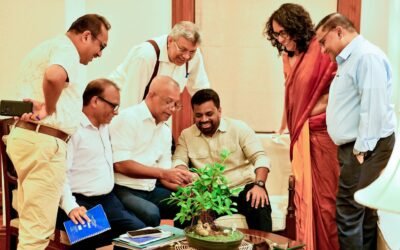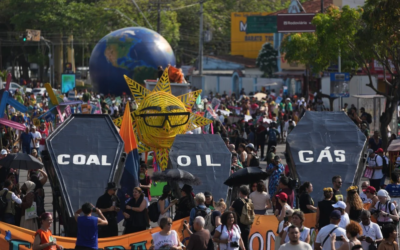Mary and Manju Emmanuel, Sarala (Director). 2021-2024. 19 mins and 24 mins respectively Pasan Jayasinghe
Pasan Jayasinghe
Contemporary social conversations about trans people often do not actually involve trans people. Instead, they are unnamed, unheard cyphers in venomous exchanges about the basic rights they deserve, and whether they represent a ‘gender ideology’ seeking to unravel society. Such debate is now a dominant sociopolitical norm in the West, and has come to infect social discourse in Sri Lanka, too. The spectre of trans and queer people as Western creations deployed to corrupt Sri Lankan cultures is not new, but it finds renewed, vigorous currency today.
Against this backdrop, Mary and Manju, two short films by Sarala Emmanuel about the lives of two elder trans women from Jaffna, should be welcomed for offering a much-needed salve. Seeing and hearing from actual trans people certainly helps clear the noise of a toxic discourse. In doing so, however, Emmanuel’s understated, gentle films go beyond mere representation, and open entirely new horizons for queer cinema in Sri Lanka.
Mary and Manju are sketches of two women grappling with their transness, how the society they lived in reacted to them, and how they live their lives now. These narratives have untold significance because they have not been seen on screen before. Not only because Mary and Manju are trans women, but because they are of the generation born in the 1960s and particularly because they have lived in Jaffna before, through and after the war. As a result, both films are full of what would be revelations for any audience.
On a first take, these revelations centre on gender. Mary and Manju offer two distinct visions of being trans. Mary’s life is marked by periods of uncertainty about her gender—conditioned by discrimination from parts of her family and community—before she comes to an understanding of herself as a woman. Manju is less definitive about her gender, making a living through a range of differently gendered professions and going about her life with a variety of gender expressions. The way the two describe, and display, their genders suggests a transience and fluidity, and paints in very real terms what transness is and can be. The films mirror this offhandedly, pausing on how Manju’s arms undulate gracefully to an old Tamil film song, or how Mary softly adjusts her hair and sari.
The pair negotiate their genders even more strikingly with the society around them which, for considerable portions of their lives, was the one governed by the Liberation Tigers of Tamil Eelam (LTTE). Publicly noted as being ‘different’, Mary is summoned by the LTTE’s Women’s Wing and given an ultimatum to choose between living as a woman or a man. This enables her to present as female in public for the first time in her life. When the LTTE outlaws koothu performances, Manju, a koothu dancer, must take on multiple feminised roles for the movement. She becomes a dancer in patriotic plays portraying female victims of Sri Lankan Army violence, as well as a cook and carer for injured Tiger cadres. The films carefully do not suggest a universality to these experiences. Nonetheless, they mark out how gender is socially constructed, but with a levity defying any theoretical connotation.
Gender is not the only dimension where Mary and Manju touch on the fluidity of identity. Mary converts to Catholicism because she is not required to remove her shirt to enter a church, as she must when entering a Hindu temple. She now manages a shrine to the Velankanni Matha (‘Our Lady of Good Health’). Manju, meanwhile, is now a poosari at three Hindu temples, presenting as male while conducting temple duties. Both attest to the special status thirunangai (transgender women) have in their locality; which is more easily taken in by their community via their spiritual practices. Here, they move through faith and spirituality with a fluidity that perhaps parallels their transness.
On the category of ethnicity, the films intimate further flux. Manju’s mother is Ilankai Tamil and her father Malaiyaha Tamil, and she comes to Jaffna when displaced by the 1977 anti-Tamil pogrom which left her father dead. She recalls the numerous anti-Tamil slurs from Sinhalese at the time, just after breaking jarringly, delightfully, into a Jayamangala Gatha, offering that she was born in Tissamaharama in the Buddhist deep South after all. Further in Manju’s recollections is the LTTE’s forced expulsion of Muslims from Jaffna in 1990; and how Raghu, a Muslim trans woman, married a Tamil woman and ‘became’ Tamil to escape persecution. All of this speaks to the complex, non-linear ways many people relate to ethnicity in Lanka, which again echoes transness.
Together, the recoveries of history the films offer are important in manifold ways. Mary and Manju’s six or so decades of existence offer firm rebuke to the idea that trans people are alien to this land. Instead, their lives are living history. Mary is possibly the first person to undergo gender reassignment surgery in Sri Lanka, the trauma of which she relieves wistfully. Manju’s dizzying array of jobs maps onto many decades of changing cultural rhythms in Jaffna. They have both lived life in multitudinous, full ways, often beyond imagination.
Other inconvenient histories unearthed by the films are equally stirring, especially the arresting glimpses of life under the LTTE they recount. These colour in a society with far more complicated social dynamics than the monolithically repressive society the Sri Lankan government and Sinhala nationalism insist it was. This insistence relies on the vacuum of information and memory the government has created itself, through its wholesale massacre, destruction, and silencing of Tamil voices and records. Mary and Manju then are forceful rejoinders to this project of erasure.
The possibilities not just of self-expression but also desire under the LTTE’s governance that the two women recount likewise complicate valorised understandings of it, especially as a staunchly disciplined militarised outfit outwardly enforcing a strict social code. Manju reveals how the caretakers of injured cadres would arrange sex for them, as relief from the pain they were bearing—she herself once taking part in a pretend wedding ceremony for a cadre ending in the consummation of the ‘marriage’. Just as Mary and Manju are not the caricatures of trans people as made out to be by wider society, neither are LTTE members the avatars they become under various nationalisms. They are all, as the films show, humans caught up in a war larger than them.
Heavy as all these revelations may be, they never feel so. Emmanuel’s films have a deliberate lo-fi aesthetic and sensibility. Shot on a phone camera, with sound that drops in and out, Mary and Manju are captured going about their daily lives and recounting their life stories conversationally. Their narration has no structure or chronology, and no other voiceover beyond the soft probing of their off-camera interlocutors. It results in a soothing, hypnotic rhythm to the films, where we hear Mary and Manju’s stories told in almost stream-of-consciousness fashion.
All this breaks possible new ground for non-scripted visual storytelling in Sri Lanka, and certainly so for films portraying trans and queer lives. By rendering trans identities squarely outside liberal modalities of ‘representation’—which often insist on trans and queer portrayals for the sake of it—they are also far stronger counters to today’s ascendent, reactionary transphobia which relies on silencing or ridiculing trans people. Any such attempt would be almost immediately negated by the glaring realness of Mary and Manju, as captured by the films.
The two women project this realness continually, but it comes most movingly when they pause to take stock. Asked about younger trans people who actively identify as trans, Manju is effusive, because they get to live with more security and less pretence than she has ever experienced. In this one affecting stroke, she reaches through history to pull out a vision of a future marked by a considerate, gracious love. That such a future becomes real, too.
Pasan Jayasinghe is a queer activist and a PhD candidate in political science at University College London.
Image Credit: Sarala Emmanuel
You May Also Like…
Dying for the Target
Ishankha Singha Arachchi
The harsh working conditions faced by workers in the pursuit of ever-intensifying production targets have long been a...
One Year On: Reading the NPP “From Below and to the Left”
Janaka Biyanwila
The National People’s Power (NPP) in Sri Lanka achieved a significant two-thirds parliamentary majority in the...
Declaration of the Peoples’ Summit towards COP30
Peoples’ Summit
16.11.25 - Belém (Brazil) We, the Peoples’ Summit, gathered in Belém do Pará, in the Brazilian Amazon, from 12 to 16...




